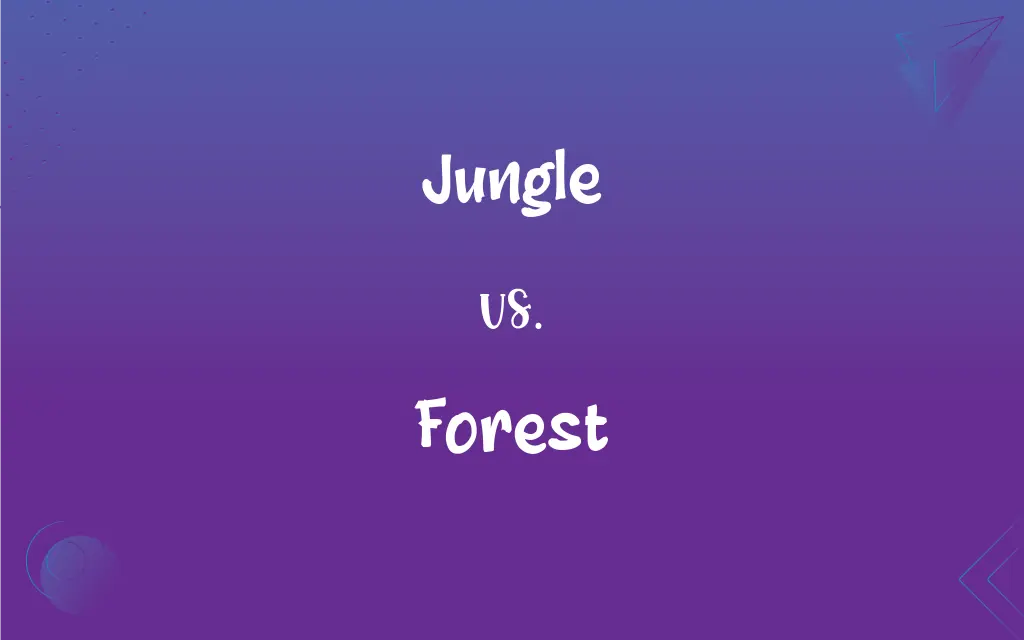Jungle vs. Forest: What's the Difference?
Edited by Janet White || By Harlon Moss || Updated on October 16, 2023
A jungle is a dense, tropical rainforest, typically hot and humid, while a forest is a large area covered chiefly with trees and undergrowth, found in both temperate and tropical regions.

Key Differences
A jungle is primarily associated with tropical rainforests that are characterized by their dense and tangled vegetation. These regions often have a hot and humid climate throughout the year. On the other hand, a forest is a vast land area covered with trees, shrubs, and undergrowth. Forests can be found in both temperate and tropical regions and have various climates depending on their location.
In terms of biodiversity, jungles are incredibly rich, housing a plethora of species. This is due to the constant warmth and high rainfall, promoting lush and dense vegetation. Forests, especially tropical forests, are also rich in biodiversity, but temperate forests might have less species diversity compared to their tropical counterparts.
Jungles often have a multilayered structure, with tall trees reaching for sunlight, followed by shorter trees, shrubs, and then ground flora. This layering is a result of the intense competition for sunlight. Forests can also have layered structures, especially in tropical regions, but temperate forests tend to have a less distinct layering due to varied seasonal changes.
Water availability differs between the two. Jungles typically receive a high amount of rainfall, ensuring constant moisture. In contrast, forests, especially temperate ones, can have varied levels of rainfall and might experience periods of dryness.
Lastly, the word jungle sometimes carries a metaphorical meaning, referring to a chaotic or competitive environment. Whereas, forest often symbolizes tranquility, vastness, and nature's beauty.
ADVERTISEMENT
Comparison Chart
Climate
Hot and humid year-round.
Varies; can be cold to hot, humid to dry.
Location
Tropical regions.
Both temperate and tropical regions.
Biodiversity
Extremely rich due to constant warmth and high rainfall.
Varies; tropical forests are rich, temperate less so.
Structure
Multilayered due to competition for sunlight.
Layered in tropics; less distinct layering in temperate.
Metaphoric Meaning
Can refer to a chaotic or competitive environment.
Symbolizes tranquility and nature's beauty.
ADVERTISEMENT
Jungle and Forest Definitions
Jungle
A wild place populated by fierce animals or unfriendly people.
Navigating the corporate jungle can be challenging.
Forest
A large area covered with trees, shrubs, and undergrowth.
The forest was serene and filled with chirping birds.
Jungle
A complex ecosystem rich in biodiversity and interdependent species.
The Amazon jungle is a vital lung of our planet.
Forest
A legal hunting ground or reserved woodland.
The king declared the area a royal forest.
Jungle
A land overgrown with tangled vegetation at ground level.
The jungle was so thick, it was hard to find a path.
Forest
A domain or sphere of activity or interest.
The mind is a forest of thoughts and emotions.
Jungle
A dense, tropical rainforest with hot and humid conditions.
I trekked through the jungle and was amazed by its diversity.
Forest
A vast, untouched, and undisturbed expanse of nature.
The forest stood as a testament to nature's majesty.
Jungle
A place of intense competition or chaos.
The city felt like a concrete jungle during rush hour.
Forest
A dense collection or amount of something.
His hair was a forest of thick, curly locks.
Jungle
Land covered with a dense growth of tropical vegetation.
Forest
A growth of trees and other plants covering a large area.
Jungle
A dense thicket or growth.
Forest
A large number of objects bearing a similarity to such a growth, especially a dense collection of tall objects
A forest of skyscrapers.
FAQs
What's a primary reason for the multilayered structure of a jungle?
Intense competition for sunlight.
Can forests be found in cold regions?
Yes, forests can be in both temperate (cold) and tropical regions.
What climate is typical for a jungle?
Hot and humid year-round.
Can you find coniferous trees in a forest?
Yes, especially in temperate and boreal forests.
Do forests always have a dense undergrowth like jungles?
Not always; it varies depending on the type and location of the forest.
What's a metaphorical meaning of the word jungle?
It can refer to a chaotic or competitive environment.
How do the water levels in a jungle typically compare to a temperate forest?
Jungles usually have consistent moisture due to high rainfall, whereas temperate forests can have varied rainfall.
Is biodiversity higher in a jungle or a forest?
It varies, but jungles, being tropical, often have incredibly high biodiversity.
Do forests have a similar metaphorical meaning?
Not usually. Forests often symbolize tranquility and nature's beauty.
Are both jungles and forests vital for Earth's climate?
Absolutely, they act as carbon sinks and play crucial roles in regulating the planet's climate.
Are all jungles located in tropical areas?
Primarily, yes. Jungles are mainly in tropical regions.
What's a significant threat to both jungles and forests worldwide?
Deforestation, often due to logging and agriculture.
Can you find jungles in Africa?
Yes, regions like the Congo basin house dense tropical jungles.
Do animals typically found in jungles differ from those in forests?
Yes, due to the difference in climates and environments.
Are forests always natural formations?
No, there are also man-made or planted forests.
Are the Black Forest and the Amazon a comparison of forest vs. jungle?
Yes, the Black Forest is a temperate forest, and the Amazon is a tropical jungle.
Are all forests protected areas?
No, but many are designated as protected areas or reserves.
What kind of human settlements can you find in jungles?
Often tribal or indigenous communities.
Can you find deciduous trees in a forest?
Yes, especially in temperate forests where trees shed leaves seasonally.
What's the primary difference between a rainforest and a jungle?
All jungles are rainforests, but not all rainforests are jungles. Jungles typically have denser undergrowth.
About Author
Written by
Harlon MossHarlon is a seasoned quality moderator and accomplished content writer for Difference Wiki. An alumnus of the prestigious University of California, he earned his degree in Computer Science. Leveraging his academic background, Harlon brings a meticulous and informed perspective to his work, ensuring content accuracy and excellence.
Edited by
Janet WhiteJanet White has been an esteemed writer and blogger for Difference Wiki. Holding a Master's degree in Science and Medical Journalism from the prestigious Boston University, she has consistently demonstrated her expertise and passion for her field. When she's not immersed in her work, Janet relishes her time exercising, delving into a good book, and cherishing moments with friends and family.































































